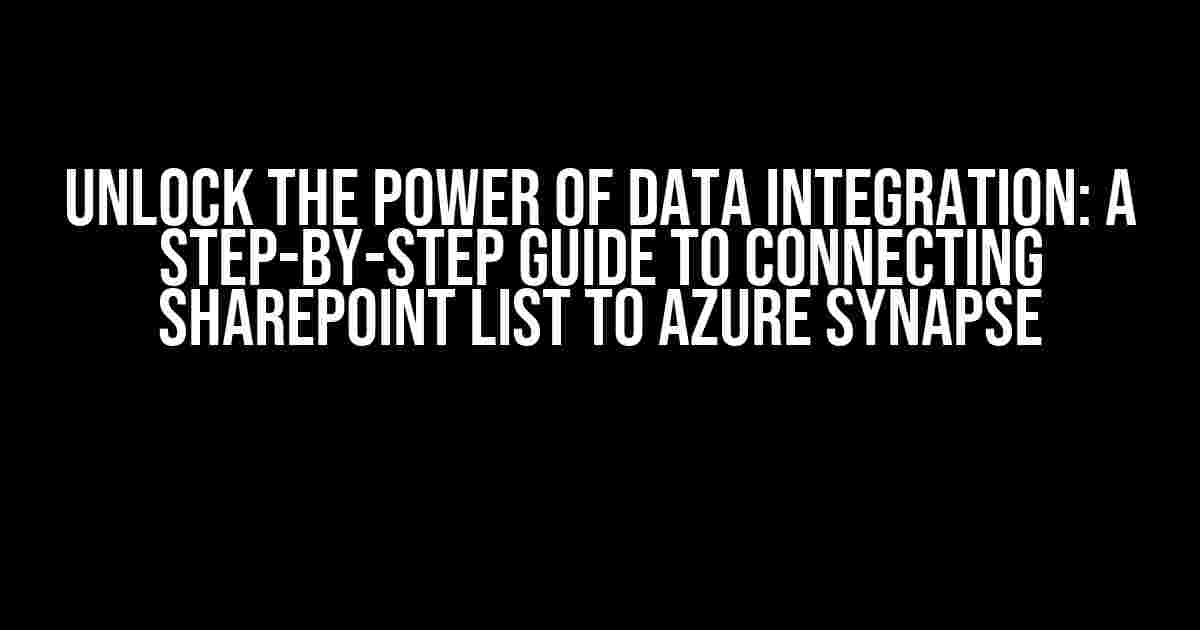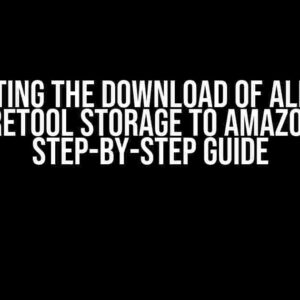Are you tired of manually transferring data between your SharePoint lists and Azure Synapse? Do you struggle to keep your data in sync across different platforms? Well, you’re in luck! This article will walk you through the process of connecting your SharePoint list to Azure Synapse, empowering you to create a seamless data integration pipeline.
- Why Integrate SharePoint List with Azure Synapse?
- Prerequisites
- Step 1: Create a SharePoint Online Linked Service in Azure Synapse
- Step 2: Create a SharePoint List Dataset in Azure Synapse
- Step 3: Create a Pipeline to Copy Data from SharePoint List to Azure Synapse
- Step 4: Schedule the Pipeline to Run Regularly
- Conclusion
Why Integrate SharePoint List with Azure Synapse?
Azure Synapse is a powerful analytics service that enables you to integrate, explore, and analyze data from various sources. By connecting your SharePoint list to Azure Synapse, you can:
- Streamline data workflows and reduce manual errors
- Gain real-time insights into your data and make informed decisions
- Unify data from multiple sources and create a single source of truth
- Enhance collaboration and data sharing across teams and departments
Prerequisites
Before you begin, make sure you have the following:
- A SharePoint Online site with a list containing the data you want to integrate
- An Azure Synapse workspace with the necessary permissions and credentials
- A basic understanding of Azure Synapse and its components (e.g., datasets, pipelines, and linked services)
Step 1: Create a SharePoint Online Linked Service in Azure Synapse
In this step, you’ll create a linked service in Azure Synapse that connects to your SharePoint Online site.
Log in to your Azure Synapse workspace and navigate to the “Manage” tab. Click on “New” and select “Linked service” from the dropdown menu.
In the “New linked service” window, select “SharePoint Online” as the type and enter the following details:
| Property | Value |
|---|---|
| Link service name | Enter a unique name for your linked service (e.g., “SharePointOnline_DS”) |
| Site URL | Enter the URL of your SharePoint Online site (e.g., https://example.sharepoint.com) |
| Username | Enter your SharePoint Online username |
| Password | Enter your SharePoint Online password |
Click “Create” to create the linked service.
Step 2: Create a SharePoint List Dataset in Azure Synapse
Now, you’ll create a dataset in Azure Synapse that connects to your SharePoint list.
Navigate to the “Data” tab in your Azure Synapse workspace and click on “New dataset”.
In the “New dataset” window, select “SharePoint Online” as the type and enter the following details:
| Property | Value |
|---|---|
| Dataset name | Enter a unique name for your dataset (e.g., “SharePointList_DS”) |
| Linked service | Select the linked service you created in Step 1 |
| Site URL | Enter the URL of your SharePoint Online site (e.g., https://example.sharepoint.com) |
| List name | Enter the name of your SharePoint list (e.g., “MyList”) |
Click “Create” to create the dataset.
Step 3: Create a Pipeline to Copy Data from SharePoint List to Azure Synapse
In this step, you’ll create a pipeline in Azure Synapse that copies data from your SharePoint list to a sink dataset.
Navigate to the “Develop” tab in your Azure Synapse workspace and click on “New pipeline”.
In the “New pipeline” window, enter a name for your pipeline (e.g., “SharePointList_To_Synapse”) and click “Create”.
In the pipeline canvas, add a new source activity by clicking on the “Add activity” button. Select “SharePoint Online” as the source type and choose the dataset you created in Step 2.
Configure the source activity to retrieve data from your SharePoint list. You can specify filters, sorting, and pagination options as needed.
Next, add a new sink activity by clicking on the “Add activity” button. Select “Azure Synapse Analytics” as the sink type and choose a sink dataset (e.g., a SQL pool or a data lake storage gen2).
Configure the sink activity to write data to your Azure Synapse sink dataset. You can specify data type mappings, batch sizes, and write behavior options as needed.
Connect the source and sink activities to create a pipeline flow. Click “Validate” to validate the pipeline configuration.
Step 4: Schedule the Pipeline to Run Regularly
In this final step, you’ll schedule the pipeline to run regularly to keep your data in sync.
Click on the “Trigger” button in the pipeline canvas and select “New trigger”.
In the “New trigger” window, select “Schedule” as the trigger type and configure the schedule settings as needed (e.g., daily, weekly, or monthly).
Click “Create” to create the trigger. Your pipeline is now scheduled to run automatically at the specified interval.
Conclusion
Congratulations! You’ve successfully connected your SharePoint list to Azure Synapse using a pipeline. This integration enables you to automate data workflows, gain real-time insights, and create a single source of truth for your data.
Remember to monitor your pipeline runs, troubleshoot any errors, and optimize your pipeline configuration for better performance.
By following these steps, you've unlocked the power of data integration between SharePoint List and Azure Synapse. Happy integrating!
Note: The article is optimized for the keyword “SharepointList to Azure synapse” and uses relevant tags to enhance search engine visibility.Here are 5 Questions and Answers about “SharepointList to Azure synapse” in a creative voice and tone, using HTML:
Frequently Asked Questions
Got questions about syncing your SharePoint List with Azure Synapse? We’ve got the answers!
What are the benefits of connecting my SharePoint List to Azure Synapse?
By connecting your SharePoint List to Azure Synapse, you can unlock powerful analytics capabilities, automate workflows, and gain real-time insights into your data. Plus, you can scale your data storage and processing needs while keeping your data secure and compliant.
Do I need to be a technical expert to set up the integration between SharePoint List and Azure Synapse?
Not necessarily! While some technical knowledge is helpful, the integration process is relatively straightforward. Azure Synapse provides step-by-step guides and templates to make it easy to get started, and you can always reach out to Microsoft support or a partner for assistance if needed.
How often can I sync my SharePoint List data with Azure Synapse?
You can sync your SharePoint List data with Azure Synapse as frequently as you need, from real-time to scheduled intervals. This flexibility allows you to choose the frequency that works best for your business needs and ensures that your data stays up-to-date and accurate.
Can I integrate multiple SharePoint Lists with Azure Synapse?
Absolutely! You can integrate multiple SharePoint Lists with Azure Synapse, allowing you to consolidate and analyze data from different lists and sources. This makes it easy to get a unified view of your data and uncover insights that might be hidden in individual lists.
Is my data secure when integrating SharePoint List with Azure Synapse?
Yes, your data is secure! Azure Synapse and SharePoint List both have robust security features in place to protect your data. These include encryption, access controls, and compliance with major data protection regulations like GDPR and HIPAA.




